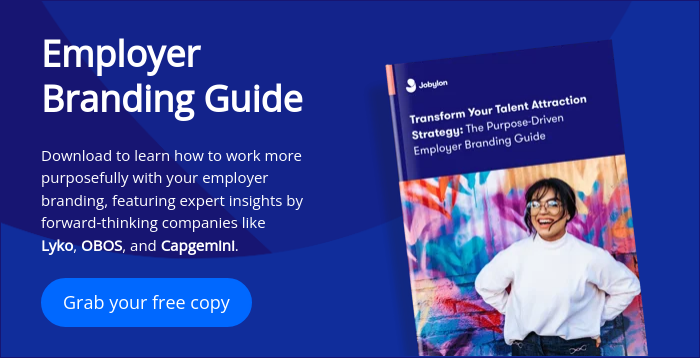Staying up-to-date with the latest trends and statistics is essential for crafting effective recruitment strategies. These statistics not only provide insights into the current state of the job market, but they also offer valuable guidance for attracting and retaining top talent. In this article, we will discuss the ten most important employer branding statistics for 2023, their context, and best practices to leverage these insights effectively.
#1: 79% of job seekers consider employer reputation before applying for a job
Insight:
In today's job market, candidates are becoming increasingly discerning about the companies they choose to work for. Employer reputation plays a significant role in influencing job seekers' decision-making process. This trend emphasizes the importance of building and promoting a positive employer brand to attract the best candidates.
Best Practices:
- Invest in building a strong employer brand that highlights the company's values, mission, and culture.
- Showcase employee testimonials, success stories, and workplace perks to elevate your employer reputation.
- Leverage social media platforms, such as LinkedIn and Glassdoor, to engage with candidates and share your company's unique selling points.
(Source: Corporate Responsibility Magazine)
#2: Approximately 82% of employees would leave their current job for a company with an excellent reputation.
Insight:
A strong employer reputation not only helps attract top talent but also leads to improved employee retention. Employees are more likely to stay with a company that has a positive brand image and offers a favorable work environment.
Best Practices:
- Foster a positive work culture and prioritize employee engagement to create an excellent reputation among current and potential employees.
- Communicate your employer brand consistently across various touchpoints, including career websites, job ads, and social media platforms.
- Encourage current employees to share their positive experiences on review sites like Glassdoor and leverage employee advocacy to amplify your brand message.
(Source: LinkedIn Employer Branding Playbook)
#3: Companies with positive employer brands receive twice as many applications per job posting compared to companies with negative employer brands.
Insight:
A strong employer brand has a direct impact on the number and quality of applications received for job openings. Companies with positive employer brands have a competitive advantage in attracting a larger pool of qualified candidates.
Best Practices:
- Optimize your job postings to reflect your employer brand and attract the right candidates.
- Develop an employee referral program to encourage your existing employees to refer potential candidates who align with your brand values.
- Leverage content marketing to create engaging and informative articles that showcase your company's industry expertise and values, ultimately attracting top talent.
(Source: LinkedIn Employer Branding Playbook)
#4: 72% of candidates share their negative interview experiences online or with someone they know.
Insight:
Candidates who have a negative interview experience are more likely to share their experiences online or with others, potentially damaging your employer brand. Poor candidate experiences can spread quickly and harm your chances of attracting future top talent.
Best Practices:
- Create a candidate-centric interview process that respects candidates' time and provides them with a positive experience.
- Communicate clearly with candidates throughout the interview process and provide timely feedback.
- Use candidate feedback to continuously improve your recruitment process and identify areas for enhancement.
(Source: Talent Board's 2021 Candidate Experience Report)
#5: 77% of employees are more likely to stay with a company that demonstrates a commitment to diversity and inclusion.
Insight:
Companies that prioritize diversity and inclusion have a higher chance of attracting and retaining top talent. Employees are seeking workplaces that foster an inclusive environment, where diverse perspectives are valued and celebrated.
Best Practices:
- Develop a comprehensive diversity and inclusion strategy that includes goals, programs, and initiatives to actively promote a diverse workforce.
- Implement unconscious bias training to ensure fairness during the recruitment and selection process.
- Highlight your commitment to diversity and inclusion through company communications, core values, and community involvement.
(Source: Glassdoor's Diversity and Inclusion Study)
#6: 92% of job seekers believe that transparency about pay and benefits is a significant factor in considering a job offer.
Insight:
In an era of increased transparency, potential candidates are seeking information about pay and benefits to make informed decisions. Employers who are transparent in their compensation packages have a better chance of attracting top talent.
Best Practices:
- Be transparent about salary ranges and benefits offered during the recruitment process.
- Provide clear information about additional perks, such as professional development opportunities, work-life balance initiatives, and flexible working options.
- Regularly review and benchmark compensation packages to remain competitive in the market.
(Source: Glassdoor's Mission and Culture Survey)
#7: 67% of candidates consider the availability of remote work as an important factor when choosing a job.
Insight:
The COVID-19 pandemic has accelerated the acceptance and adoption of remote work. Job seekers now prioritize flexibility in their work arrangements, with a significant percentage considering remote work availability an essential factor when considering a job offer.
Best Practices:
- If feasible, offer remote work options or flexible work arrangements to attract talent seeking a better work-life balance.
- Highlight your company's remote work policies in job postings and across various employer branding channels.
- Showcase success stories and employee testimonials about the benefits of remote work within your organisation.
(Source: FlexJobs' 2021 Survey)
#8: 87% of employees expect their employer to support their mental health and well-being.
Insight:
Workplace well-being and mental health support has become a top priority for employees. Companies that invest in employee well-being programs and support resources demonstrate their commitment to the overall health of their workforce.
Best Practices:
- Develop a comprehensive mental health and well-being program that includes resources for stress management, work-life balance, and mental health support.
- Offer flexible work arrangements and encourage breaks to promote a healthy work-life integration.
- Promote employee well-being initiatives internally and externally as part of your employer branding efforts.
(Source: LinkedIn's Workplace Mental Health Report)
#9: 76% of candidates prefer to apply for jobs through an easy-to-use mobile application process.
Insight:
The shift towards mobile technology and the increasing reliance on smartphones have made mobile-friendly application processes crucial. Companies that provide a seamless mobile experience have a higher chance of attracting tech-savvy candidates.
Best Practices:
- Optimize your career website and application process for mobile devices to remove barriers and make it convenient for candidates to apply on the go.
- Implement a user-friendly applicant tracking system (ATS) that can streamline the application process and provide a positive user experience.
- Conduct regular testing to ensure your mobile application process is responsive, intuitive, and user-friendly.
(Source: CareerBuilder's 2021 Candidate Behaviour Study)
#10: Only 14% of employees believe their employers excel at employer branding.
Insight:
Many companies still have room for improvement when it comes to employer branding. With such a small percentage of employees believing their employers excel at cultivating their brand, there is a significant opportunity to stand out from the competition by focusing on your employer brand.
Best Practices:
- Evaluate your current employer branding strategies and make necessary improvements to align with your target talent audience.
- Conduct internal surveys or focus groups to gather employee feedback and gain insights into your current employer brand perception.
- Collaborate with marketing and HR teams to develop an integrated employer branding strategy that encompasses both internal and external messaging.
(Source: LinkedIn's 2021 Global Talent Trends Report)
Conclusion
Employer branding is becoming increasingly important in attracting and retaining top talent. By staying informed about the latest trends and statistics, you can adapt your recruitment strategies to effectively navigate the evolving job market. Leverage the insights discussed above, and align your employer branding efforts with the expectations and preferences of job seekers to gain a competitive advantage in attracting the best talent for your company.





